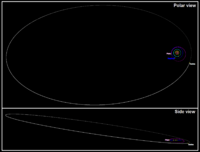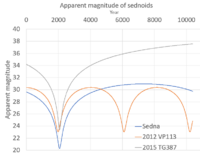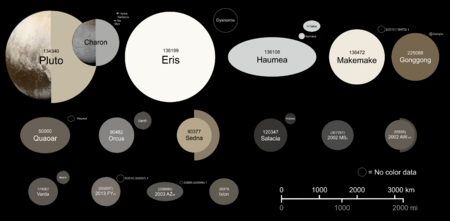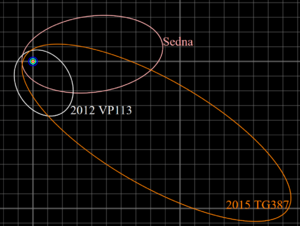Sedna (dwarf planet) facts for kids
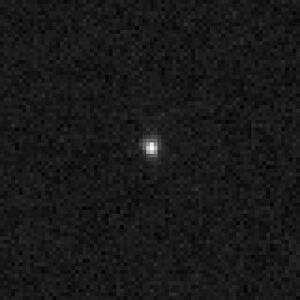
A fuzzy image of Sedna taken by the Hubble Space Telescope in 2004.
|
|
| Discovery | |
|---|---|
| Discovered by | Michael Brown Chad Trujillo David Rabinowitz |
| Discovery site | Samuel Oschin Telescope |
| Discovery date | 14 November 2003 |
| Designations | |
| MPC designation | (90377) Sedna |
|
Named after
|
Sedna (Inuit goddess of the sea) |
| 2003 VB12 | |
| Trans-Neptunian object Detached object Sednoid Dwarf planet |
|
| Adjectives | Sednian |
| Orbital characteristics | |
| Epoch 31 May 2020 (JD 2458900.5) | |
| Uncertainty parameter 2 | |
| Observation arc | 30 years |
| Earliest precovery date | 25 September 1990 |
| Aphelion | about 937 AU |
| Perihelion | 76.19 AU |
| about 506 AU | |
| Eccentricity | 0.8496 |
| about 11,400 years | |
|
Average orbital speed
|
1.04 km/s |
| 358.117° | |
|
Mean motion
|
0.00008020° / day |
| Inclination | 11.93° |
| 144.248° | |
| Around July 2076 | |
| 311.352° | |
| Physical characteristics | |
|
Mean diameter
|
about 900–1,000 km |
| Mass | Unknown |
|
Mean density
|
Unknown |
|
Equatorial surface gravity
|
Unknown |
|
Equatorial escape velocity
|
Unknown |
| 10.273 hours | |
| 0.41 | |
| Temperature | about -261 °C (-438 °F) |
| Very red | |
| 20.8 | |
| 1.83 | |
Sedna (also known as 90377 Sedna) is a dwarf planet located in the freezing, dark outer edges of our Solar System. It orbits the Sun much farther away than Neptune. Discovered in 2003, this cold world is one of the reddest objects known in the Solar System.
Scientists studying the light from Sedna have found that its surface is a mix of frozen water, carbon dioxide, and other icy materials. It is also covered in a reddish, sticky substance called tholins. These are created when simple chemicals are exposed to sunlight for billions of years. Sedna is too cold to have an atmosphere.
Sedna is about 1,000 km wide, which is almost as big as Saturn's moon Tethys. It is one of the largest dwarf planets that we know of that does not have its own moon. Without a moon, it is very hard for scientists to figure out how much mass Sedna has.
Contents
A Long and Lonely Journey
Sedna's orbit is one of the biggest in the Solar System. It takes about 11,400 Earth years for Sedna to make just one trip around the Sun! This is the longest orbital period of any known large object in our solar system.
Its path is a very stretched-out oval, which is called a highly eccentric orbit.
- Perihelion is its closest point to the Sun, at about 76 AU. One AU is the distance from the Earth to the Sun. So even at its closest, Sedna is 76 times farther from the Sun than we are.
- Aphelion is its farthest point from the Sun, at a huge distance of about 937 AU. This is about 19 times farther away than Pluto gets.
Because it gets so far away, Sedna is one of the coldest places in the Solar System. Temperatures there can drop to –240°C (–400°F). From Sedna's surface, the Sun would just look like a very bright star.
Sedna is currently moving toward its perihelion, which it will reach around the year 2076. Even though it's getting closer, other dwarf planets like Eris and Gonggong are currently farther away from the Sun than Sedna is.
When it was first discovered, scientists thought Sedna rotated very slowly. But later measurements showed it has a rotation period of about 10 hours, which is more normal for an object of its size.
History of Sedna
How Was Sedna Discovered?
Sedna was discovered on November 14, 2003, by a team of astronomers: Michael Brown, Chad Trujillo, and David Rabinowitz. They were using the Samuel Oschin telescope at Palomar Observatory in California.
They noticed a faint object moving very slowly against the background of stars. This slow movement told them it was extremely far away. They used other telescopes around the world to track it and figure out its amazing orbit.
How Did Sedna Get Its Name?
The discovery team nicknamed the object "The Flying Dutchman" after a legendary ghost ship because it was so hard to spot.
For the official name, they chose Sedna, after the Inuit goddess of the sea, who is said to live in the cold depths of the Arctic Ocean. The team felt this was a good name for such a cold and distant world. The name was officially accepted by the International Astronomical Union (IAU) in 2004.
What is Sedna Like?
Sedna is a small world, with a diameter of about 900 to 1,000 km. This makes it smaller than Pluto's largest moon, Charon.
Its most famous feature is its color. Sedna is one of the reddest objects in the Solar System, almost as red as Mars. Scientists believe this deep red color comes from a thick layer of organic sludge called tholins. Tholins are complex molecules that form when simple compounds like methane are hit by radiation from space over billions of years.
Observations from telescopes, including the James Webb Space Telescope, have shown that Sedna's surface is a mix of frozen water, ethane, and other complex organic materials. This mix of materials makes Sedna a very interesting place for scientists to study.
The Mystery of Sedna's Orbit
Sedna's strange orbit is a huge puzzle for astronomers. It's too far from Neptune for Neptune's gravity to have pushed it into its current path. So, how did it get there? Scientists have a few exciting ideas.
Was It a Passing Star?
One idea is that when our Solar System was very young, it formed in a cluster of other stars. A star may have passed very close to our Sun and its gravity could have pulled Sedna into its strange, stretched-out orbit.
Could a Hidden Planet be the Cause?
Another popular theory is that there is a giant, undiscovered planet far beyond Neptune. This hypothetical world, often called Planet Nine, might be six times more massive than Earth. Its powerful gravity could be shaping the orbits of Sedna and other distant objects, keeping them in a group.
Was Sedna Stolen from Another Star?
A third idea is that Sedna didn't even form in our Solar System! It might have been captured by our Sun's gravity from a passing star system billions of years ago. If this is true, Sedna would be an "extrasolar" object, giving us a chance to study a piece of another star system up close.
Are There More Like Sedna?
Because Sedna's orbit is so large, it spends most of its time being too far away and faint to see. The fact that we found it at all suggests there could be many more objects like it out there. These objects are now called sednoids.
In 2014, astronomers found another sednoid, called 2012 VP113. In 2018, they found a third one, Leleākūhonua, which has an even longer orbit of 40,000 years. All of these objects have similar orbits, which strengthens the case for a hidden Planet Nine that might be guiding them.
Finding more sednoids will help scientists solve the mystery of how they, and our entire Solar System, were formed.
Is Sedna a Planet?
When Sedna was discovered, some people called it the "tenth planet." However, scientists now have a clear definition for what makes a planet. According to the International Astronomical Union (IAU), an object must do three things to be a planet:
- It must orbit the Sun.
- It must be large enough for its own gravity to make it round.
- It must have "cleared its neighborhood," meaning its gravity has swept its path clear of other, smaller objects.
Sedna checks the first two boxes. It orbits the Sun and it is large enough to be round. However, it has not cleared its neighborhood. Its orbit is full of other icy bodies.
For this reason, Sedna is classified as a dwarf planet, just like Pluto, Eris, and Ceres. Dwarf planets are round, planet-like worlds that just haven't cleared their orbits.
Future Missions to Sedna
Sedna will make its closest approach to the Sun around 2076. This is a rare opportunity to study it up close, an opportunity that won't come again for over 11,000 years.
Scientists have calculated that a spacecraft could be launched in 2033 or 2046. It would use a gravity assist from Jupiter to get a speed boost. Even with this help, the journey would take about 25 years. A mission to Sedna would give us amazing new information about the farthest reaches of our Solar System.
See also
 In Spanish: (90377) Sedna para niños
In Spanish: (90377) Sedna para niños


